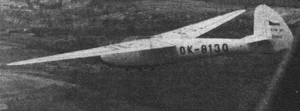Zlin Z-25 Šohaj
| Z-25 Šohaj | |
|---|---|

| |
| Šohaj 1 in 1948 | |
| Role | Club glider |
| National origin | Czechoslovakia |
| Manufacturer | Zlin Aircraft
|
| Designer | L. Marcol, L. Smrček |
| First flight | 1947 |
| Number built | more than 286 |
| Developed from | DFS Olympia Meise |
The Zlín Šohaj (English: Laddy) series of club gliders began as a post World War II development of the DFS Olympia Meise. A large number were built in the 1940s and '50s.
Design and development

The Z-25 Šohaj was designed to be a replacement for the pre-war,
ovoid cross section fuselage, enabling a smoother aerodynamic junction than on the Meise, which had a high wing on an almond shaped fuselage.[1]
The Šohaj is an all wood-framed aircraft, covered in a mixture of
stalling speed and, through the increased wing loading, raised the maximum cross country speed between thermals.[1][2]
The fuselage of the Šohaj is completely ply skinned, tapering to the tail. The single seat
elevators to be ahead of the deep rudder, which is protected by a tail bumper. There is an elevator trim tab to adjust for different pilot weights The Šohaj 1 lands on a simple, rubber sprung skid but the later models have a fixed, semi-recessed monowheel just behind the skid which now ends under mid-wing.[1][2][3]
Operational history
At least 286 Šohajs were built, with Šohaj 3 production extending in the later 1950s.
Variants



- Z-25 Šohaj
- Initial version. Skid undercarriage. First flew 1947.
- Zlin Z-25 Šohaj
- LG-125 (Z-125) Šohaj 2
- Monowheel undercarriage, otherwise similar to Šohaj 2. 126 produced.
- VT-425 (Z-425) Šohaj 3
- Monowheel, Fowler flaps, increased span 600 mm (23.6 in) and revised nose and canopy. 59.5 kg (131 lb) heavier than Šohaj 1. 160 produced. First flown 1955.
Specifications (VT-425 Šohaj 3)
Data from The World's Sailplanes (1963) pp.60-1[2]
General characteristics
- Crew: One
- Length: 7.19 m (23 ft 7 in) overall
- Wingspan: 15.6 m (51 ft 2 in)
- Wing area: 14.20 m2 (152.8 sq ft)
- Aspect ratio: 17.1
- Airfoil: NACA 23015 at root, NACA 4412 tip
- Empty weight: 215 kg (474 lb)
- Gross weight: 330 kg (728 lb)
- Wing loading: 23.20 kg/m2 (4.75 lb/sqft)
Performance
- Maximum speed: 220 km/h (140 mph, 120 kn) placard, smooth air
- Aero tow speed: 140 km/h (87 mph; 76 kn)
- Winch launch speed: 100 km/h (62 mph; 54 kn)
- Stall speed: 56 km/h (35 mph, 30 kn) 10° flaps
- Rate of sink: 0.78 m/s (154 ft/min) minimum, at 66 km/h (41 mph; 36 kn)
- Lift-to-drag: maximum 26
See also
Related lists
References
Wikimedia Commons has media related to Zlin Z-25 Šohaj.
- ^ ISBN 3-9807977-4-0.
- ^ a b c Shenstone, B.S.; Wilkinson, K.G. (1963). The World's Sailplanes. Vol. II. Organisation Scientifique et Technique Internationale du Vol à Voile (OSTIV) and Schweizer Aero-Revue. pp. 60–1.
- ^ "New Czech Sailplane". Flight. Vol. LIII, no. 2043. 19 February 1948. p. 216.
- ^ "Internationals". Flight. Vol. 66, no. 2374. 23 August 1957. p. 126.
- ^ "France wins 1954 Contests". Sailplane and Glider. XII (5): 4. September–October 1954.
